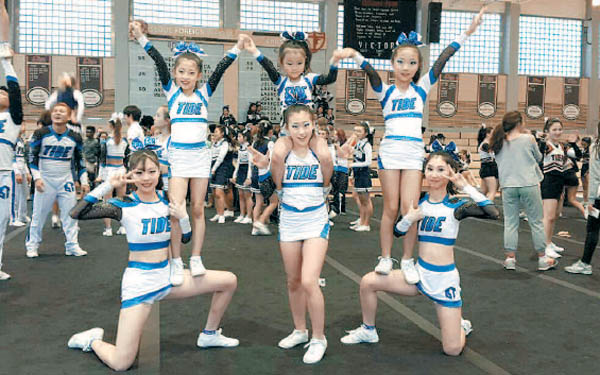Cheerleading flies high among Korean youths

Korean national cheer team BigTide, with members ranging from kindergartners to adults, demonstrates at the 2015 Korean-American Interscholastic Activities Conference competition at Korea International School in February. By Lee Yeon-jin
The popularity of cheerleading among Korean students is quite novel, considering that it remained a foreign sport for over a decade in Korea. Although cheerleading was first introduced to the country in 2000, only a number of professional cheer squads had access to training from adept coaches, and they had few opportunities to perform in front of the public.
“Many people still perceive cheerleading as either dancing or cheering at certain professional sports tournaments, but this perspective is far from what cheerleading really is,” said Kang Hoon, coach of the BigTide cheerleading team, which, as the first Korean cheerleading team, played an important role in inspiring teens to start in the sport.
“Cheerleading teaches important life values, such as preparation, dedication and cooperation as a team, and helps boost self-esteem,” said Shin Seung-hyun, captain of Varsity Cheer at Hankuk Academy of Foreign Studies. “I think cheerleading involves more than just cheering the home team to victory or performing crowd-pleasing stunts.”
Notably, central and local governments are encouraging cheerleading by sponsoring and hosting competitions. Annual events, such as the National Assembly Cheerleading Competition, Jongno Cheer Competition, Seocho Cheer Competition and Superintendent of Education Cheer, are officially sponsored by the government.
The Korea Cheerleading Association (KCA), established in 2003 and sponsored by the Ministry of Culture, Sports and Tourism, is another entity that has been publicizing cheerleading. The KCA has been spreading media content via social networking service, supervising a number of competitions and events in Korea and training athletes to become professional coaches.
Several benefits of cheerleading appeal to teenagers.
“Individuals sacrifice their personal pursuits for the sake of the team. They also have to finish the whole routine with a positive attitude,” said Isaac Kim, an experienced male cheerleader for BigTide. “These features improve leadership skills and instill a positive mind-set, which is integral to the alleviation of academic stress and to the mental development of teenagers,”
High school students have been forming school cheer clubs and practicing not only to perform in diverse festivals, but also in competitions.
Despite its rising popularity, Korean cheerleading still faces barriers in its development. Popular opinion is that cheerleading seems dangerous because of its inferior practice environment. Cheerleading requires a mat for safety and protection, as well as qualified, experienced coaches to instruct and demonstrate gymnastic techniques like tumbling, jumping, pyramids and basket tosses.
“Cheerleading is not only a sport, but also a work of art,” Kang said. “There might be some people who deny cheerleading is a sport, but I hope this very appealing activity gains recognition from the public.”
yeonjin.lee17@stu.siskorea.org
BY LEE DA-YOUN, LEE YEON-JIN [dianelee0502@gmail.com]










with the Korea JoongAng Daily
To write comments, please log in to one of the accounts.
Standards Board Policy (0/250자)